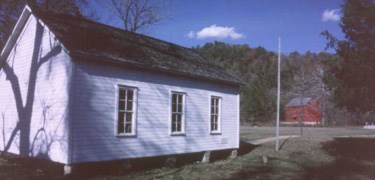
A visit to Storys Creek School on the grounds of the Alley Mill allows a glimpse of a time gone by. The little white, one room school house is an image of pioneer education near and dear to most Americans. It exemplifies a simpler time, a time when life was less stressful and education more effective. Unfortunately, like many such romantic images, the truth is both greater and less than our imaginings. Unpainted log schools were the first on the vast frontier, followed by clapboard structures, some painted, some not. When they were painted, white was the most common color, but almost any color you can imagine was applied to some school somewhere. Missouri had strict regulations about the color of the schools. White was mandatory forall wooden schools, except log ones of course. The interiors had to be painted a light blue. The one room school house is not the exclusive property of the pioneers. They continued in use in some areas until the very recent past. They were in widespread use in rural Missouri until 1957, when they were consolidated with town school districts. In the Missouri Ozarks,consolidation took place around the end of the 1950s, with many one room schools operating into 1959. A few parochial one room schools continue in Missouri, Pennsylvania, Ohio and other states to this day. The rugged landscape of the Ozarks made travel difficult in the early days ofsettlement. Roads were few and poor, usually little more than wagon ruts. Unlike most other areas, the Ozarks also lacked centralized towns and cities. People tended to live on widely scattered homesteads, farming and hunting for their needs, only rarely going to commercial centers for trade goods they couldn't make on their own. 
Once a school was established in an area, it became a sort of focus. Children from the local area could meet each other and mingle. As they grew to know each other, a sense of belonging to a particular area grew. They were developing a sense of community. Since the school was often the only community building, it quickly evolved into a community center of sorts. Elections were held there, church services, and even weddings regularly took place in the one room schools. One traditional activity at a one room school was the "pie supper."Jackie Cheatham, who attended a one room school near Huzzah, Missouri, says that "every woman or girl brought a pie in a decorated box. An auctioneer sold each pie to the highest bidder. The idea, of course, was for the men and boys to buy the pies of the woman with whom they wanted to eat. It was supposed to be a secret who had prepared each pie box, but the girls always made sure their boyfriends knew which box to bid on." Teachers became part of the communities they served. Typically, they would board with a local family. In many communities it was prestigious to have the school teacher stay at your home for a term. As teachers frequently came and went, there were ample opportunities for different families to have theprivilege of hosting them. Many people are taken with the notion that one room schools provided a better education than modern schools. Like any other generalization, this belief is both true and false. Teachers were largely responsible for whether or not their pupils (often called "scholars") got a good education. Then as today, there were some excellent teachers, some terrible teachers, and a vast majority of hardworking, good competent teachers trying to get the job done. The difference was that if you had the same excellent teacher for six or eight years, you received a great education. If you had a poor teacher for the same length of time, you might not have fared so well. 
Bill O'Donnell Educational methods were different in the one room school than they are today. Children of several different grades were exposed to similar materials. Younger students could "preview" what they would be learning later. Older students were encouraged to assist the younger ones in learning their lessons, which both helped develop leadership skills and helped the teacher with the workload! The grade structure we know today was somewhat different. Children would read through text books called "primers," the famous McGuffey Reader is a familiar example. The primers were written for different levels of ability, first, second and so on. A child might be on his third primer (equal to about third grade) in reading, but only at a first grade level in math or civics. Letting children advance at their own pace, and allowing older students to tutor the younger eventually faded from the educational scene in the U.S. Students then were not necessarily any more motivated than students today. Mrs Cheatham recalls that some of "these kids were not the finest of students, nor did their parents see much value in education. They attended until the age of sixteen, when the State of 
Of course many students, hopefully most, did value their education. Mrs Cheatham remembered that "the school library consisted of about 50 very old, dusty books tucked into a small closet. I often finished my work with time to spare and was allowed to fill out the time by visiting the library. Since I had never seen another library, I thought I'd died and gone to Heaven. I read every book at least once and many of them several times."
"Rivers are the primal highways of life. From the crack of time, they had borne men's dreams, and in their lovely rush to elsewhere, fed our wanderlust, mimicked our arteries, and charmed our imaginations in a way the static pond or vast and savage ocean never could." - (Tom Robbins, Fierce Invalids from Hot Climates)
|
Last updated: January 5, 2018
